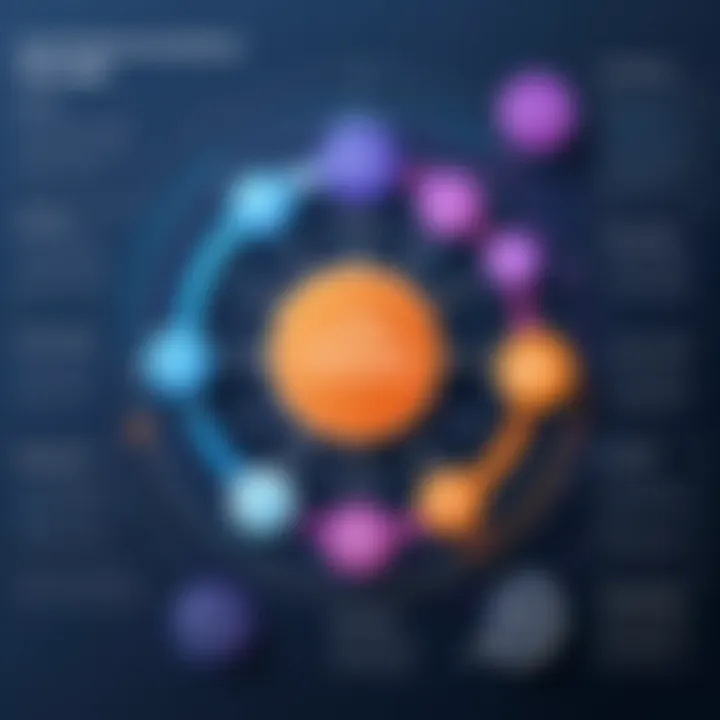Harnessing Loyalty Programs as a Service for Business Growth


Intro
In the fast-paced world of business, customer loyalty often sets successful brands apart from the rest. With the rise of digital innovations, the way businesses foster this loyalty has morphend significantly. Enter Loyalty Programs as a Service (LPaaS)—a dynamic approach transforming traditional loyalty strategies into fully integrated, technology-driven systems.
LPaaS allows organizations to tap into advanced methodologies for managing customer relationships while enhancing the overall experience. By offering tailored solutions, this model enables companies to engage effectively with their consumers, promoting long-term retention and satisfaction. The need for agility and personalization has prompted many brands to explore the potential of LPaaS, making it a crucial topic for decision-makers, IT professionals, and entrepreneurs.
Through this discourse, we will dissect the various elements of LPaaS, spotlighting both its core features and the user experience it provides. We will evaluate case studies that illuminate real-world applications, address potential challenges, and set sights on future trends. As the business landscape evolves, understanding LPaaS can be a significant competitive advantage for those willing to embrace change.
Overview of Core Features
The essence of LPaaS lies in its ability to streamline loyalty mechanisms while providing a robust framework for engaging customers. Here we will dissect the primary functionalities that define LPaaS solutions, allowing businesses to appreciate their potential impact fully.
Description of essential functionalities
At the heart of LPaaS, several features stand out:
- Real-time Analytics: This feature enables businesses to monitor customer behaviors continuously. By capturing data on purchase patterns, preferences, and engagement, companies can make informed decisions to optimize their offerings.
- Personalization Engines: Tailor experiences based on individual customer profiles. Such engines utilize sophisticated algorithms to provide recommendations and rewards that resonate with the user’s preferences.
- Multi-channel Integration: A vital aspect of LPaaS is the ability to engage customers across various platforms—be it mobile applications, websites, or in-store interfaces. This cohesive approach ensures brand consistency while enhancing accessibility.
- Flexible Reward Structures: Unlike traditional loyalty programs, LPaaS offers businesses customizable reward frameworks, allowing for points, tiers, and exclusive offers that align with their brand strategies.
Comparison of features across top software options
When exploring LPaaS solutions, several platforms emerge with distinct advantages:
- Yotpo: Known for its robust user-generated content integration, Yotpo enables businesses to leverage customer reviews and ratings, effectively boosting engagement through social proof.
- LoyaltyLion: This platform prides itself on its advanced analytics and reporting tools, providing insights into customer trends and behaviors from multiple sources.
- Smile.io: Ideal for e-commerce businesses, Smile.io focuses on seamless integrations with platforms like Shopify and WooCommerce, making it easier to manage customer loyalty initiatives.
Despite these differences, all these services share a common goal of enhancing customer retention through innovative strategies.
User Experience and Interface
In any technology-driven service, user experience is paramount. LPaaS is no exception, as successful implementation greatly depends on a well-designed interface that promotes usability.
Insights into UI/UX design aspects
The user interface should be visually appealing but also functional and intuitive. Key design principles include:
- Clarity: A straightforward layout ensures users can navigate easily without feeling overwhelmed.
- Consistency: Maintaining a uniform design throughout different channels instills trust and reliability.
- Feedback Mechanisms: Providing immediate feedback on user actions helps customers understand their status within the loyalty program.
Importance of usability and accessibility
Furthermore, accessibility cannot be overstated. Platforms must adhere to essential guidelines, ensuring that users of all abilities can engage effortlessly. This not only broadens the customer base but also reinforces the brand’s reputation as inclusive and forward-thinking.
"A well-executed loyalty program can thrive on efficiency, simplicity, and an unwavering commitment to customer experience."
As LPaaS continues to evolve, understanding these foundational aspects will empower businesses to adapt swiftly and capitalize on emerging trends.
Understanding Loyalty Programs
In a world where competition is fiercer than ever, loyalty programs serve as a beacon of hope for businesses eager to foster enduring customer relationships. Understanding loyalty programs goes beyond just recognizing their existence—it's about grasping their underlying mechanisms and inherent value. These programs are not merely rewards; they are strategic tools designed to enhance customer retention and lifetime value. They cultivate a sense of belonging among customers, making them feel valued and special.
Defining Loyalty Programs
At their core, loyalty programs are structured marketing strategies that reward customers for their repeat business. They come in all shapes and sizes, from points-based systems, such as those implemented by airlines or retail giants, to tiered rewards that provide escalating benefits based on purchase frequency. For instance, a coffee shop might offer a punch card style program: buy ten coffees and earn the next one free. This simple mechanic encourages frequent visits.
Loyalty programs can incorporate various elements, including discounts, exclusive member benefits, and personalized offers. The idea is simple—recognize and reward loyalty in a way that resonates with consumers.
Importance of Customer Loyalty
Customer loyalty is the lifeblood of any business. It not only drives repeat purchases but also significantly reduces marketing costs. The old adage, "It's cheaper to keep a customer than to acquire a new one," rings especially true in today’s business climate. Loyal customers tend to spend more over time and are more likely to recommend a brand to others.
Moreover, in an era where consumer choices abound, loyalty programs help distinguish a brand from its competitors. A robust loyalty initiative offers something unique, creating emotional connections that can transform a one-time buyer into a lifelong advocate.
In summary, understanding loyalty programs provides valuable insights into customer behavior and preferences, essential for any business strategy aimed at long-term success. These insights can lead to improved customer experiences and ultimately contribute to a healthier bottom line.
"Companies that cultivate customer loyalty enjoy a profit margin that is typically 20 percent higher than their non-loyal counterparts."
With this foundation, we can explore the next layer: how Loyalty Programs as a Service (LPaaS) are reshaping the landscape.
Loyalty Programs as a Service Explained
Loyalty programs have evolved significantly in recent years, mainly driven by the demands of an increasingly digital consumer landscape. The rise of Loyalty Programs as a Service (LPaaS) represents a paradigm shift in how businesses approach customer loyalty. This is not just about accumulating points for purchases anymore; it’s a comprehensive, scalable service that provides companies with the tools and insights necessary to cultivate long-lasting customer relationships.
Concept of LPaaS
At its core, LPaaS is a cloud-based solution that allows businesses to manage and optimize their loyalty programs without the extensive infrastructure traditionally required. Imagine companies being able to implement advanced loyalty solutions quickly, without the hassle of developing and maintaining complex systems in-house. This service allows businesses of any size to access state-of-the-art loyalty mechanisms, analyze customer behaviors, and customize engagement strategies on-the-fly.
The sophistication provided by LPaaS enables organizations to adapt to changing consumer expectations quickly.
- Flexibility: Businesses can modify their loyalty programs based on real-time data, experimenting with different rewards or engagement tactics, without the costly commitment of traditional software.
- Cost-Effective: Reducing the need for extensive IT resources, LPaaS lowers barriers for small and medium enterprises to engage in effective loyalty strategies.
- Scalable Solutions: As the business grows, LPaaS can easily accommodate increased customer volumes and additional features.


"Loyalty Programs as a Service is not just a technology solution; it's a strategic approach to customer engagement that can transform industries."
Differentiating LPaaS from Traditional Programs
When contrasting LPaaS with traditional loyalty programs, the differences become readily apparent. Traditional programs often rely on rigid structures, like physical cards or limited rewards, and they can struggle to adapt to modern consumer behavior. Here are some key differences:
- Implementation: Traditional programs typically require a lengthy setup, with significant investments in infrastructure. On the other hand, LPaaS can be spun up in a matter of weeks, allowing businesses to respond quickly to market shifts.
- Data Utilization: Where traditional programs might only track basic customer transactions, LPaaS digs deeper. It harnesses comprehensive analytics, providing insights into customer preferences and behavior that fuel personalized communication and offers.
- Customer Engagement: Loyalty programs of yesteryear often took a one-size-fits-all approach. LPaaS encourages segmentation and targeted strategies, meaning not every customer receives the same offer. Customizing experiences fosters a deeper connection with individual consumers, which is vital in today’s crowded marketplace.
In essence, LPaaS is redefining what it means to engage customers, creating dynamic relationships rather than static rewards systems.
Key Components of LPaaS
Understanding the key components of Loyalty Programs as a Service (LPaaS) is essential for businesses aiming to harness customer loyalty effectively. These elements work together to create not only a functional program but also an engaging and efficient experience for both the business and its customers. Here, we will explore the three crucial components: Technological Infrastructure, User Experience Design, and Data Analytics Integration.
Technological Infrastructure
In the digital age, a solid technological foundation underpins effective LPaaS. The infrastructure must support seamless integration with existing systems, ensuring that all customer interactions are smooth and data flows freely between various platforms. This includes considering the cloud-based systems that many organizations are leaning towards.
An essential part of this infrastructure is the software backbone where the loyalty program operates. Choose a system that is scalable, offering features that can adapt to your business's evolving needs. For instance, a small local bookstore’s LPaaS might look vastly different from a global retail chain’s program.
Key elements to keep in mind:
- Integration Capabilities: Ensure the system can connect easily with CRM, POS, and e-commerce platforms.
- Security Measures: Protecting customer data through encryption and compliance with regulations, like GDPR, is crucial.
- Cloud Services: Analyzing cloud-based solutions can enhance your flexibility in accessing the service.
Overall, when businesses invest in the right technological infrastructure, they lay the groundwork for a successful loyalty program.
User Experience Design
Creating a user-centric design is pivotal in the realm of LPaaS. It's not just about functionality but also about how customers interact with and perceive the loyalty program. If the design is clunky and difficult to navigate, even the best loyalty benefits could fall flat.
Considerations in user experience design include:
- Simplicity and Clarity: A straightforward signup process and easy access to rewards can mean a world of difference. Users appreciate when things don't feel complicated.
- Responsive Design: With more consumers using mobile devices for shopping, having a loyalty program that functions well on all screens is non-negotiable.
- Personalization: This goes beyond just putting a customer’s name on an email; intelligent design incorporates user data to provide tailored recommendations and rewards.
Essentially, the goal is to foster an enjoyable and intuitive experience that keeps customers coming back, thus driving loyalty at every turn.
Data Analytics Integration
Data is the lifeblood of any loyalty program. Integrating advanced analytics into LPaaS lets businesses understand their customers deeply. The insights gained can help fine-tune marketing strategies and optimize customer engagement.
Data analytics integration involves:
- Real-Time Reporting: Businesses can monitor program performance and customer behavior patterns in real time, allowing them to make quick adjustments.
- Customer Segmentation: By analyzing data, companies can group customers based on preferences and behaviors, tailoring communications and offers that resonate with each segment.
- Predictive Analysis: Businesses can forecast future trends based on historical data, enabling preemptive updates to their loyalty approaches.
By leveraging data analytics, companies not only gain insights but also develop proactive strategies, which are vital to staying ahead in a competitive landscape.
"A program without understanding its data is like a ship without a compass; you may move forward, but you won't know in which direction."
In summation, the key components of LPaaS — Technological Infrastructure, User Experience Design, and Data Analytics Integration — are foundational to creating effective loyalty programs. By focusing on these elements, businesses can create a robust framework that promotes customer retention and enhances overall business performance.
Advantages of Implementing LPaaS
When it comes to customer retention, Loyalty Programs as a Service (LPaaS) offer a modern solution tailored for today's intricate market needs. Implementing LPaaS delivers an array of benefits that can significantly influence a business's ability to engage with its customers more effectively, ensuring that they return for service or purchase. Given the fast-paced evolution of consumer expectations, LPaaS represents not just a method of retaining customers but also a strategic framework for enhancing relational dynamics and operational efficiencies.
Cost Efficiency and Scalability
One of the standout advantages of LPaaS is the cost efficiency it brings to the table. Traditional loyalty programs can be heavy on resources, needing extensive upfront investments in technology and maintenance. LPaaS, on the other hand, allows businesses to utilize cloud-based solutions that reduce the burden of infrastructure costs. With a pay-as-you-go model, companies save cash as they pay only for the services they use, which can lead to substantial savings over time.
Scalability is another key aspect. As businesses grow, their customer bases often expand rapidly. Traditional loyalty programs may struggle to keep up, requiring significant adjustments to accommodate new users and data. LPaaS adjusts seamlessly, allowing companies to scale their loyalty initiatives without uprooting existing setups. This ability to expand programs effortlessly facilitates meeting evolving customer engagement demands.
Personalization of Customer Experience
In today's market, a one-size-fits-all approach is not enough. Customers are seeking personalized experiences that cater to their preferences and behaviors. LPaaS enables businesses to serve tailored offers and promotions based on detailed analytics of customer data. By understanding purchase patterns and preferences, companies can deliver highly relevant rewards that resonate with individual users.
Using LPaaS, businesses can implement targeted campaigns, enhancing customer engagement. For example, if a customer frequently buys organic products, a store could offer discounts on such items, thereby increasing the probability of further purchases. This level of personalization not only boosts customer satisfaction but also fosters a deeper emotional connection to the brand, making customers more than just occasional buyers.
“Personalization turns a transaction into a relationship.”
Enhanced Customer Insights
Effective decision-making relies heavily on data. LPaaS simplifies the integration of data analytics into loyalty programs, providing businesses with comprehensive customer insights. With access to real-time data, companies can make informed adjustments to their strategies, optimizing each interaction with clients.
This analytical advantage allows businesses to identify trends, such as which products are most popular among loyal customers or which promotions are resulting in the highest engagement. Furthermore, this understanding can help companies predict future buying behaviors, making it easier to stay ahead of the curve.
Moreover, enhanced customer insights can drive the development of new service offerings. By recognizing gaps in customer satisfaction or preferences, businesses can innovate accordingly, ensuring that loyalty programs remain relevant in a competitive landscape. This aligns perfectly with the overarching goal of not just retaining customers but also promoting brand advocacy through exceptional service delivery.
Challenges in LPaaS Implementation


Implementing Loyalty Programs as a Service (LPaaS) carries its share of hurdles that businesses must navigate to ensure effective integration and sustainability. Addressing these challenges is crucial, as they directly influence the success of loyalty initiatives and, ultimately, customer retention. As organizations increasingly turn to LPaaS solutions, understanding the potential obstacles is vital. This section discusses three major challenges: data security and privacy concerns, integration with existing systems, and user adoption and engagement.
Data Security and Privacy Concerns
In this digital age, customer data is the new gold. For LPaaS, safeguarding this data is not just a regulatory obligation but a fundamental trust builder between a company and its customers. A breach or mishandling of sensitive information can lead to devastating consequences, including loss of customer loyalty and reputational damage.
Moreover, with regulations like GDPR and CCPA booming on the horizon, businesses must tread lightly. Organizations need to ensure they are compliant with these laws, which necessitates rigorous data management protocols. This means employing strong encryption and conducting regular security audits. Failing to do so can lead to hefty fines and legal issues, further complicating an already intricate integration process.
"Data security is not just an IT issue; it’s a business issue. If there's a leak, customer trust can evaporate in a heartbeat."
Integration with Existing Systems
Another typical speed bump in LPaaS adoption is integrating these new services with current systems. Most companies have legacy systems that are not only different but also outdated. Integrating LPaaS often requires technical expertise and a clear roadmap. This integration can chip away at the initial cost savings and present unforeseen expenses, detracting from the overall effectiveness of the loyalty program.
Additionally, if the new LPaaS tools do not interact seamlessly with other customer relationship management (CRM) systems or databases, it can create silos of information. Siloed data limits the potential for personalized customer engagement and can negate the advantages that LPaaS aims to provide. Therefore, companies must invest in a strategic integration plan, which accounts for current infrastructure and future scalability.
User Adoption and Engagement
Even with the best technical framework in place, if users—both employees and customers—are not on board, the program can flounder. The transition from traditional loyalty programs to a service-oriented model may be daunting to some employees, leading to lower engagement and effectiveness.
To encourage user adoption, businesses should focus on change management principles. Providing thorough training and showcasing the benefits of the new system can ease these transitions. Similarly, customer engagement relies on intuitive design and genuine incentive offerings. If loyalty rewards are confusing or not enticing enough, customers will likely bypass the program altogether.
To bolster adoption rates, companies can consider:
- Incentivizing employees to learn and promote new practices.
- Simplifying user interfaces to reduce confusion.
- Collecting feedback for continuous improvement.
The End
Navigating the challenges of LPaaS implementation requires careful planning and resource allocation. Addressing data security, ensuring smooth integration, and facilitating user adoption are all critical elements that can significantly influence a company's loyalty program outcomes. Understanding these challenges deeply prepares businesses to transform potential setbacks into avenues for growth.
Real-World Case Studies
In the realm of Loyalty Programs as a Service (LPaaS), real-world case studies serve as a crucial compass. They provide a tangible lens through which decision-makers can view the impact of LPaaS on customer engagement and retention. Insights gleaned from both successful strategies and unfortunate failures illuminate pathways that businesses might choose to tread. Understanding these narratives can inform better decisions and strategies moving forward.
Successful Implementations
One of the standout examples of a successful LPaaS implementation can be observed in Starbucks. The company rolled out a mobile app that doubles as a loyalty program. Not only does it allow customers to earn rewards with each purchase, but it also integrates their purchasing data to offer personalized recommendations. A customer buys a latte every Monday morning; the app remembers this habit and can suggest a pastry that goes well with it. This sort of targeted engagement leads to increased sales and customer loyalty over time.
In contrast, Sephora has harnessed LPaaS to build an intensely personalized experience. Their Beauty Insider program offers points for purchases and engagement activities like reviews and social media shares. By leveraging data analytics, Sephora can segment customers based on behaviors and tailor offers that resonate more deeply with lifestyle preferences. This personalized approach has resulted in a robust community of loyal customers who feel valued and seen.
Lessons from Failed Initiatives
However, success is often accompanied by missteps, and learning from failures is equally as important. Case in point, the attempt by Gap to revamp its loyalty program failed to resonate with its audience. The Gap's loyalty plan was perceived as too complex and uninviting. Customers found it difficult to navigate the program, leading to disengagement. In such scenarios, businesses must prioritize simplicity and intuitive design. If customers feel overwhelmed rather than engaged, they're unlikely to stick around.
Another example involves the infamous struggle of Toys “R” Us when they attempted to implement a digital loyalty program. The company focused heavily on the technology aspect, neglecting the actual experience of the consumer. In the toy market, where emotions run high, the lack of genuine customer connection proved detrimental. The failure here illustrates that while technology is important, creating a personal touch remains essential.
"The roots of learning are bitter, but the fruit is sweet." - Aristotle
Through these case studies, it's clear that LPaaS can significantly impact customer loyalty, but that impact is contingent on thoughtful implementation that places the customer experience at the forefront. Adapting lessons from both successes and failures allows businesses to innovate while avoiding pitfalls that can derail engagement efforts.
Future Trends in Loyalty Programs
In today’s fast-paced world, loyalty programs must evolve to keep up with changing consumer expectations and technological advancements. The future trends in this arena not only hold the potential to elevate engagement but also redefine the customer-business relationship. Recognizing and understanding these trends is crucial for decision-makers, IT professionals, and entrepreneurs who are on the frontline of shaping loyalty initiatives. Below, we will delve into three key trends that are set to transform loyalty programs—blockchain technology, AI-driven personalization, and omnichannel strategies.
Emergence of Blockchain Technology
Blockchain, known primarily as the backbone of cryptocurrencies, is gaining traction within loyalty programs. The decentralized nature of blockchain provides transparency and security that traditional loyalty programs often lack. Program participants can securely verify their points and transactions, reducing fraud and instilling trust.
"Blockchain not only enhances trustworthiness but enhances operational efficiency by simplifying the reward redemption process."
Benefits of integrating blockchain include:
- Decentralization: Customers manage their loyalty points independently.
- Cross-Platform Acceptance: Points can be shared across various participating brands.
- Real-Time Tracking: Instant verification of point earnings and redemptions.
However, it's important to note that while the benefits are promising, integrating blockchain technology is not without hurdles. From issues related to system integration to the need for robust user education, firms must tread carefully and anticipate the challenges ahead.
AI-Driven Personalization
Artificial Intelligence is revolutionizing how businesses interact with their customers. Through data analytics, AI can ➔ effectively decipher customer preferences and behaviors, leading to hyper-personalized loyalty experiences. Such tailored approaches not only enhance engagement but also elevate customer satisfaction, creating a stronger emotional connection with the brand.
Key elements of AI-driven personalization include:
- Predictive Analytics: Anticipating customers' future needs based on historical behavior.
- Tailored Offers: Crafting promotions that resonate with individual preferences.
- Dynamic Rewards: Adapting reward structures based on real-time customer feedback.
Adopting AI technologies means businesses can continuously evolve their loyalty strategies, ensuring they remain relevant in an ever-changing marketplace.
Omnichannel Strategies


With customers interacting with brands across multiple touchpoints, an omnichannel approach has become vital. Consumers expect a seamless experience whether they're shopping online, through mobile apps, or in brick-and-mortar stores. Loyalty programs that embrace this philosophy create holistic experiences that are conducive to customer engagement.
This strategy entails:
- Unified Customer Profiles: Agencies should track customer interactions across all channels to offer a consistent experience.
- Integrated Communication: Maintain a uniform communication strategy that signifies the brand at every stage of the customer journey.
- Feedback Loops: Utilizing feedback from all platforms fosters improvements and adaptability.
Ultimately, as businesses align their loyalty programs with omnichannel strategies, they not only enhance customer retention but also bolster their brand image as customer-centric entities.
As these trends continue to shape loyalty programs, embracing innovation becomes essential for businesses aiming to thrive in a competitive landscape. Keeping an eye on advancements will be critical in driving customer loyalty forward.
LPaaS and Customer Engagement Strategies
As businesses seek to notch up their customer connections, Loyalty Programs as a Service (LPaaS) presents a nuanced approach to fostering engagement. These programs go beyond traditional loyalty schemes. They're designed to create meaningful relationships with customers. In a world where customers often feel like a number, it becomes vital to build engagement practices that resonate on a personal level. That’s where LPaaS strategies step in, allowing businesses to curate experiences tailored to individual preferences.
Creating Value through Engagement
Engagement is at the heart of any successful loyalty program. When a customer feels valued, they’re likely to stick around longer. LPaaS enables businesses to leverage data to ascertain customer behavior. By knowing what makes a customer tick, companies can offer tailored rewards. Every interaction becomes an opportunity to reinforce the relationship.
For instance, consider Starbucks and their mobile app. Not only does it let customers order ahead, but it also offers personalized bonuses based on purchase history. Such strategies create a sense of belonging in customers. They become part of a community where their preferences are recognized and catered to, turning routine transactions into enriching experiences.
Benefits of focusing on engagement through LPaaS include:
- Increased Customer Retention: Engaged customers are more likely to return.
- Higher Average Spend: Personalized offers often lead to increased purchases.
- Brand Advocacy: Customers who feel deeply connected are more inclined to advocate for the brand.
Feedback Mechanisms for Improvement
Listening to customers should never be an afterthought. In the realm of LPaaS, feedback mechanisms serve as a linchpin. They allow businesses not only to gauge customer satisfaction but also to spot opportunities for enhancing their programs. Establishing feedback channels can be as simple as utilizing surveys or net promoter scores, or even tapping into social media mentions.
Utilizing real-time feedback helps companies adapt quickly, responding to concerns before they escalate. For instance, if a new reward tier isn't resonating with users, businesses can tweak it based on insights gathered from feedback.
Moreover, incorporating feedback loops can create a sense of co-creation with customers. Engaging them in the design of programs can lead to solutions that suit their wants or needs better.
"Customer feedback is the lifeblood of successful engagement. It not only informs but transforms loyalty programs."
Key considerations for effective feedback mechanisms include:
- Simplicity: Making it easy for customers to provide feedback encourages participation.
- Timeliness: Responding swiftly to comments shows customers their opinions matter.
- Anonymity: Allowing anonymous feedback can lead to more honest and constructive responses.
In sum, LPaaS is more than a tool for managing loyalty; it's a framework for engagement. By creating value through personalized interactions and leveraging feedback for continuous improvement, businesses can forge deeper connections, significantly enhancing customer loyalty in an increasingly competitive landscape.
Evaluating the Effectiveness of LPaaS
Evaluating the effectiveness of Loyalty Programs as a Service (LPaaS) is pivotal for organizations striving to retain customers in a fiercely competitive environment. The evaluation process offers insights into how well these programs are working and whether they are meeting business objectives. Decision-makers need to focus not just on surface-level metrics but on a collection of intricate elements that genuinely reflect the program’s value.
A robust evaluation can help identify what aspects of the loyalty program truly resonate with customers. Gathering this information empowers businesses to refine their offerings, ensuring they foster lasting relationships rather than ephemeral engagements. By focusing on key performance indicators and operational metrics, companies can systematically assess the effectiveness of their LPaaS initiatives.
Key Performance Indicators
Key performance indicators (KPIs) serve as the backbone of any loyalty program assessment. They establish a clear framework for measuring success and facilitating informed decision-making. The importance of KPIs extends beyond mere numerical values; they encapsulate various aspects of customer engagement and satisfaction. Here are some of the most critical KPIs to consider in evaluating LPaaS:
- Customer Retention Rate: This metric indicates how many customers continue to engage with the loyalty program over a specified period. A high retention rate suggests that the program successfully meets customer needs.
- Participation Rate: Knowing what percentage of your customer base is actively involved in the program helps gauge its attractiveness. If participation is low, it could indicate a need for more enticing offers or user-friendly interfaces.
- Redemption Rate: The rate at which rewards are redeemed offers insights into the perceived value of the program. High redemption rates often signify effective reward structures that resonate with the audience.
- Average Order Value: Monitoring changes in average order value before and after implementing LPaaS can indicate whether the loyalty program effectively encourages spending.
- Customer Lifetime Value (CLV): Understanding the total revenue generated by a customer over their lifespan provides a deep view into the economic impact of successful loyalty strategies.
Evaluating these KPIs requires rigorous data collection methods. Businesses should leverage integrated analytics that LPaaS solutions often provide, enabling them to aggregate and analyze vast sets of data.
Operational Metrics to Monitor
Operational metrics delve into the day-to-day functioning of the LPaaS system. They provide detailed insights into its operational health and overall efficiency. Monitoring these metrics allows businesses to ensure that the technological and logistical infrastructure supports the program's strategic goals. Here are some key operational metrics worth considering:
- System Uptime: It is crucial to track the availability and performance of the LPaaS platform. Any downtime can lead to missed opportunities and eroded customer trust.
- Transaction Processing Time: The speed at which transactions are processed impacts user experience significantly. The longer it takes to redeem rewards or check balances, the more frustration customers may experience.
- User Engagement Levels: Analyzing how frequently users interact with the loyalty program can reveal engagement trends. This includes how often they access the app or website, click on promotions, or share feedback.
- Support Response Time: Monitoring how quickly customer inquiries are addressed can reflect the effectiveness of customer service associated with the LPaaS.
- Integration Efficiency: Evaluating how well the LPaaS integrates with existing customer relationship management systems is critical. Smooth integration encourages seamless user experience and operational efficiency.
Keeping a sharp eye on these operational metrics not only helps identify pain points but also assists in making necessary adjustments to enhance the low-hanging fruit.
"The metrics you choose to prioritize will dictate the strategies you implement, ultimately defining your path toward capturing and retaining customer loyalty."
By employing a comprehensive evaluation framework that encompasses both key performance indicators and operational metrics, companies can gain a clearer picture of their LPaaS effectiveness. The goal is to create a dynamic system that evolves alongside customer expectations and market demands. Doing so will enable organizations to stay a step ahead in retaining customer loyalty.
Culmination: The Future of Loyalty Programs
As we wrap up the discussion on Loyalty Programs as a Service (LPaaS), it's important to recognize that the landscape is continually shifting. In a world buzzing with advancements in technology and changing consumer expectations, businesses need to be adaptable. The future of loyalty programs isn't just about offering discounts or rewards anymore; it’s deeply rooted in understanding customers on a more personal level.
Sustaining Customer Loyalty in a Competitive Landscape
To truly sustain customer loyalty, businesses must first create an emotional connection with their clientele. Whenever customers feel valued and understood, they're far more likely to stick around. Companies should consider leveraging data analytics to predict purchasing behaviors, preferences and trends. Here are a few strategies to keep the loyalty flame burning:
- Personalization is Key: Tailoring offers based on unique customer data can dramatically enhance the loyalty experience. People appreciate when their interests are acknowledged.
- Continuous Engagement: Maintain consistent communication through multiple channels. Sending personalized messages or exclusive offers via email or social media can keep customers invested.
- Reward Innovation: Consider integrating experiential rewards that go beyond points. Offering immersive experiences or exclusive access can create lasting impressions.
Creating a loyal customer isn’t just about throwing incentives; it's about cultivating a relationship built on trust and value.
Final Thoughts on LPaaS Implementation
Implementing LPaaS requires companies to think strategically about their overall goals. While the initial setup might seem daunting, the benefits can far outweigh the risks if done correctly. When planning to roll out a loyalty program, a few considerations come to mind:
- Tech Integration: Ensure that the new LPaaS fits seamlessly into existing systems. Compatibility can save a lot of headaches down the line.
- User-Centered Design: Keep the customer experience at the forefront. Making loyalty programs user-friendly can increase adoption rates.
- Monitor and Optimize: Constantly collect feedback and analyze performance metrics. This iterative approach can help you refine and improve the program over time.



